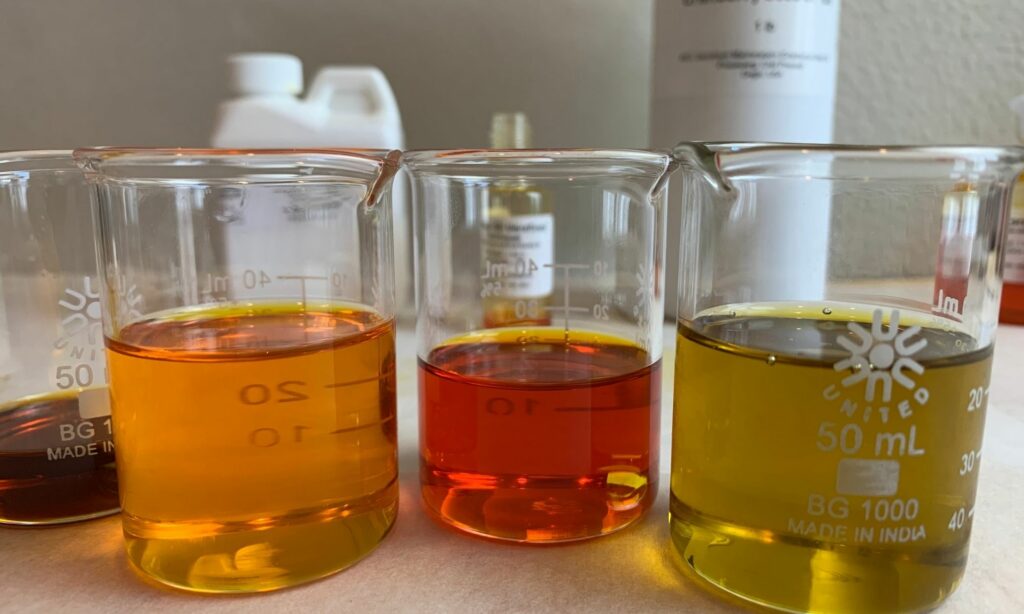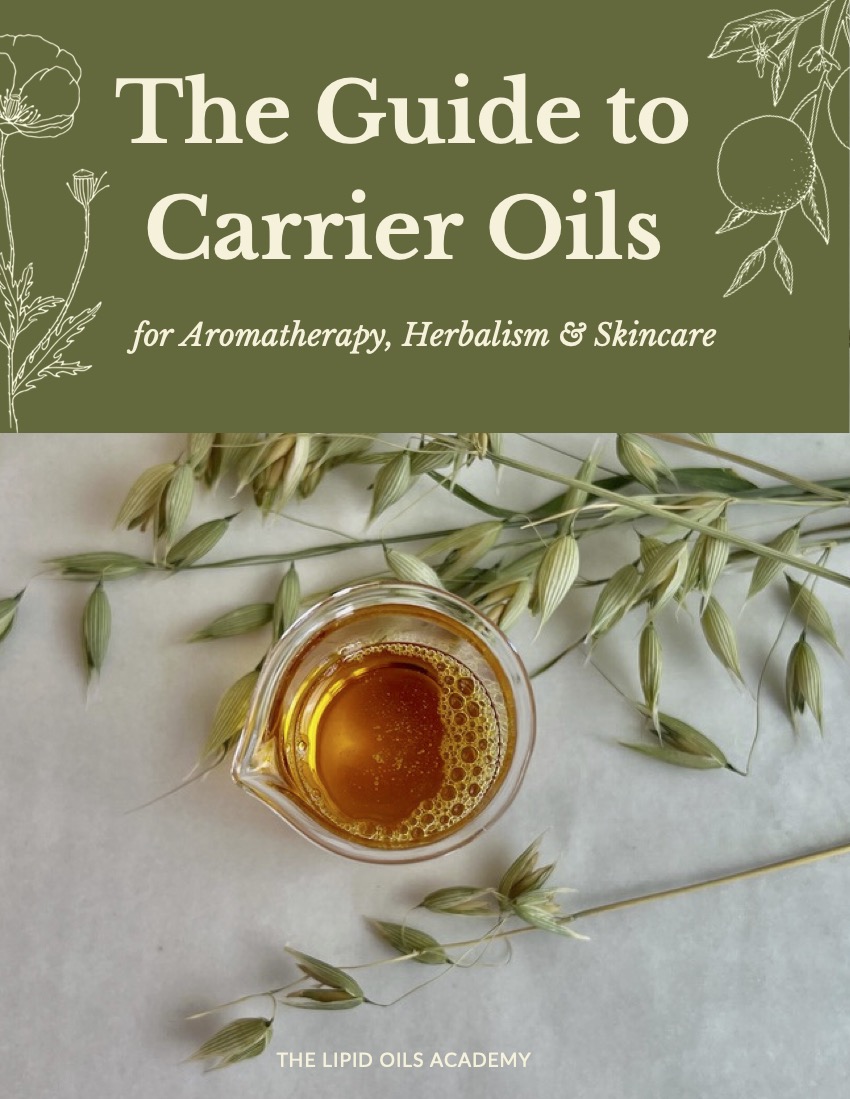The term dry oil is one I’ve been seeing used with increasing frequency in blogs and facial oil labels.
So what exactly is a ‘dry oil’?
‘Dry oil’ is a term used to describe a type of carrier oil and other lipid oils that absorb quickly into the skin to provide protection and deep moisturizing without leaving an oily residue behind.
But as the term ‘dry oil’ increasingly makes its way into the skincare conversation, I see it used interchangeably with the term ‘drying oil’. But these two terms describe very different kinds of oils.
In this post, we will look more closely at the ‘drying oils’ and ways to use them in skincare. And then in Part 2 of this series, we will go more deeply into ‘dry oils’ and look at some of the uses for these types of oils.
Drying Oil Defined
When I think of drying oils it takes me back to my art school days where we would grind pigments into linseed oil to make paints and inks.
Linseed oil is the industrial name for flaxseed oil. The flax plant’s Latin botanical name is Linum, which is how linseed oil got its name. And linseed oil has been used in making paint, inks and flooring for centuries because of the nature of its polyunsaturated fatty acids and ability to dry to the touch.
Flax oil became popular to differentiate the fresh, highly nutritious oil from the flax plant from the use of linseed oil for non food purposes. This is why keeping nutritional flax seed oil supplements in the fridge is so important! If exposed to heat, oxygen, and light, flaxseed oil can go rancid quickly loosing its health supporting properties.
So to recap, flaxseed and linseed oils are both highly polyunsaturated and will dry to the touch over time. But they are not the only ‘drying oils’ out there.
Other types of Drying Oils
- poppy seed oil
- walnut oil
- safflower oil
These are just some of the oils used historically as drying elements in paint, before the widespread use of acrylic paints.
So, outside of making your own pigments for an art project, where would you use a drying oil?
It depends on the type of oil you are working with. But, just know that when working with drying oils, good storage practice is key to keeping your oils fresh.
Walnut oil – this is both a skincare oil and a food oil! In the kitchen, walnut oil is not one to heat, at all. It is too delicate for that. Rather, drizzle a little on salads and other dishes as a finishing oil to add a deep nutty flavor.
But this is not a food blog! So let’s return to skincare uses.
Walnut oil
Walnut oil is high in polyunsaturated fatty acids and plant compounds that nourish the skin and provide anti-aging, regenerative, and moisturizing properties. Walnut oil has naturally occurring ellagic acid, an anti-oxidant that contributes anti-bacterial, inflammatory, antiviral and antiseptic properties. You’ll also find selenium, phosphorous, magnesium, zinc, iron and calcium in the unsaponifiable portion of this oil.
Best use: add to facial oils and oil serums to add a toning quality to recipes.
Poppy Seed Oil
Poppyseed oil is pressed from the seeds of opium poppies. The potent alkaloids found in the pods, flowers, and stems are absent in the seeds, however, showing up in only trace amounts. Poppyseed oil has a range of culinary and even industrial uses, including in paints and pigments as we discussed above. But what about skincare?
In skincare poppyseed oil is a rich source of linoleic acid (70%) and oleic acid (16%). It is colorless and has little scent and is a good moisturizing oil. Poppyseed oil will absorb quickly into the skin, ideal for light facial oils and body oils.
Poppyseed oil is similar to hemp seed oil and is a good substitution for hemp.
Safflower Oil
Safflower seed oil has been around for a long time. In fact, it is one of the oldest cultivated plants. Dyes from safflower plants and seeds have been found in Egyptian tombs! Including that of Tutankhamen.
In skincare, safflower seed oil is moisturizing and nourishing, and it is easily accessible and usually affordable.
Best use: as a body oil or inexpensive base oil for skincare recipes and formulas.
In part two of this series, we are going to look more closely at ‘dry oils’ as opposed to the ‘drying oils’ we’ve been discussing here.
Until then, I’d love to hear what you’re working on. Leave a question or a comment below.



Bath bombs- working on the right ratio of oil to dry ingredients then working in Pigment , sparkle and scents
Thanks Susan! Terrific info.
Thank you Susan, most informative. I am building up to make some perfume and wondering which oil to use as the base. Perhaps poppy seed oil as it absorbs quickly and is light.
The only issue with poppy seed oil is that it will have a relatively short shelf life. Meadowfoam seed oil has a nice long shelf life and feels wonderful on the skin. Or jojoba, similar to meadowfoam.
Thank you! Your posts are amazing! Very informative, yet easy to digest 😊. Looking forward to the next one
Thank you for clarifying these terms. I am wondering how you classify oils that dry out your skin? Is that more of a reaction of you skin to the oil? Example, everyone loves coconut oil…..I can’t use it because it dries my skin out.
I am working on a hand cream for rough chapped hands.
Yes, some oils do dry the skin, coconut is one. It may be because the coconut oil is made up of medium chain fatty acids which would absorb quickly but not offer as much protection as an oil or butter. Longer chain fatty acids do a better job of holding moisture in the skin – So better choices are butters like shea butter, mango butter and many of the monounsaturated oils like avocado or almond oil.
Great write-up Sudan, thank you for this. Could you please elaborate on toning quality of Walnut oil? What is meant by that, benefits for users, characteristics, etc. Thanks again!
Walnut oil is generous in polyunsaturated fatty acids that absorb well and nourish the skin. Unsaponifiable compounds from the nut oil help maintain the skin’s health.
Thank you very much for sharing information which can be understood by a layman with no science background. Really loved your book power of seeds. I can’t thank you enough for all that I am able learn from you
I’m so happy to have this difference explained and look forward to learning more. Thank you.
Thank you! Helpful as always. Working on an eye cream, and was wondering if walnut oil might be a good addition since it is toning.
Walnut oil would be wonderfully nutritious for an eye cream.